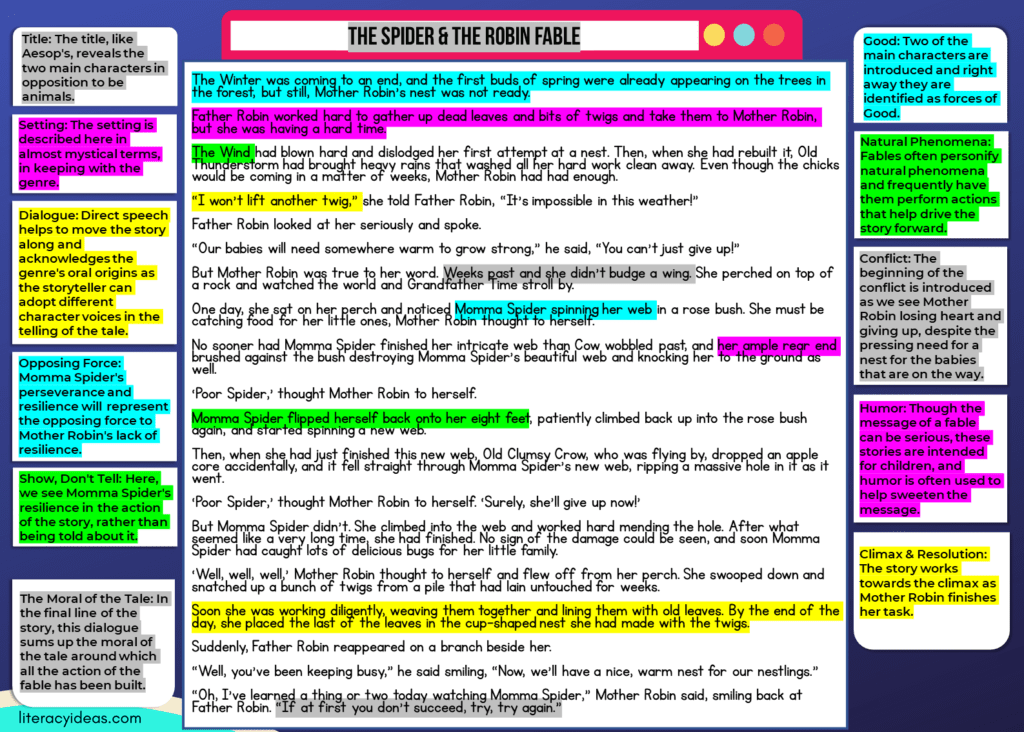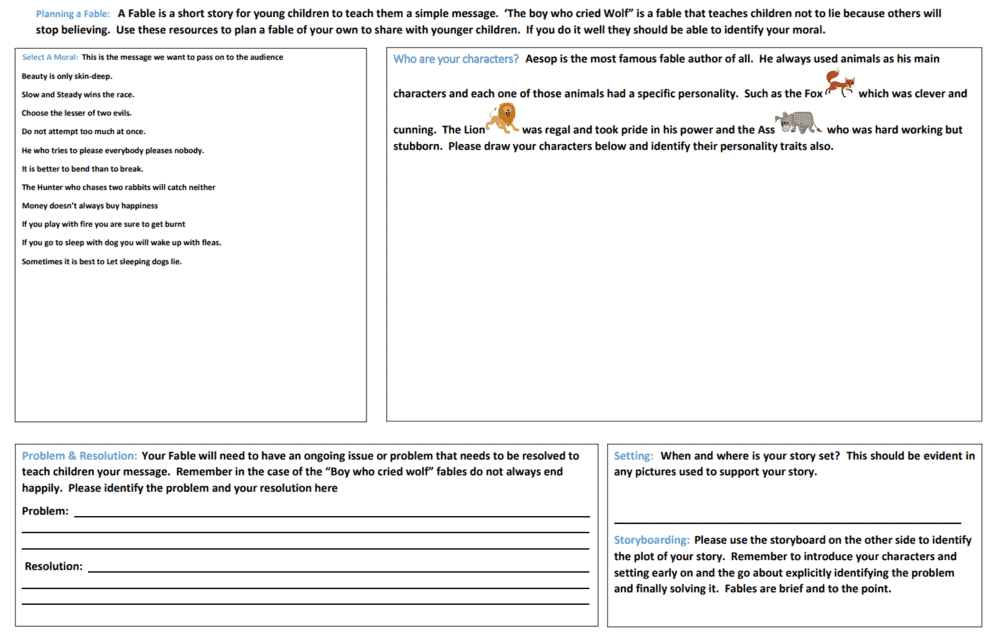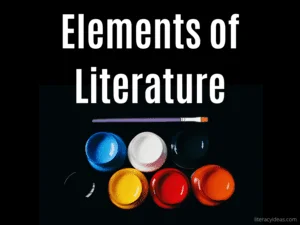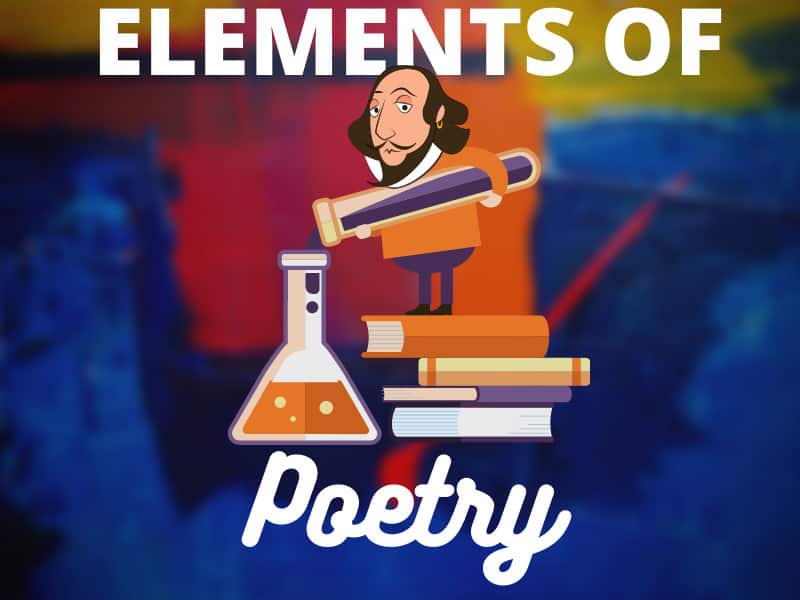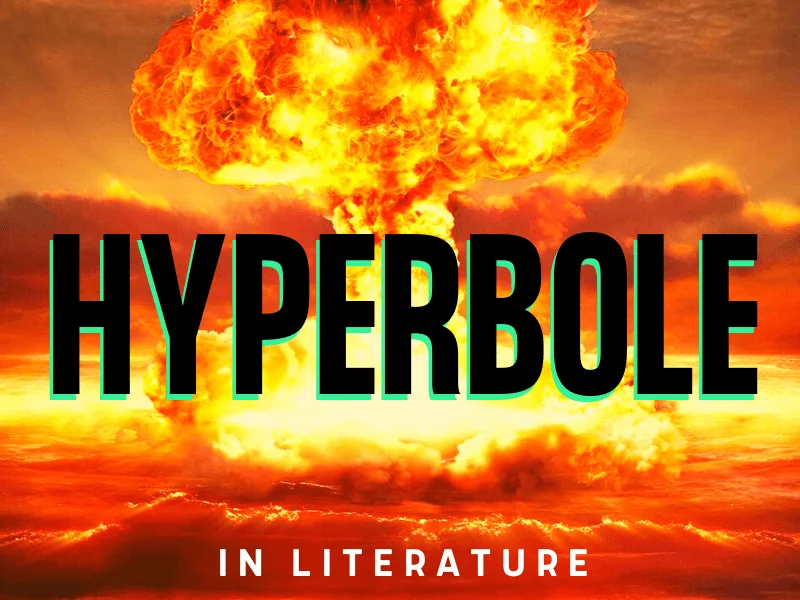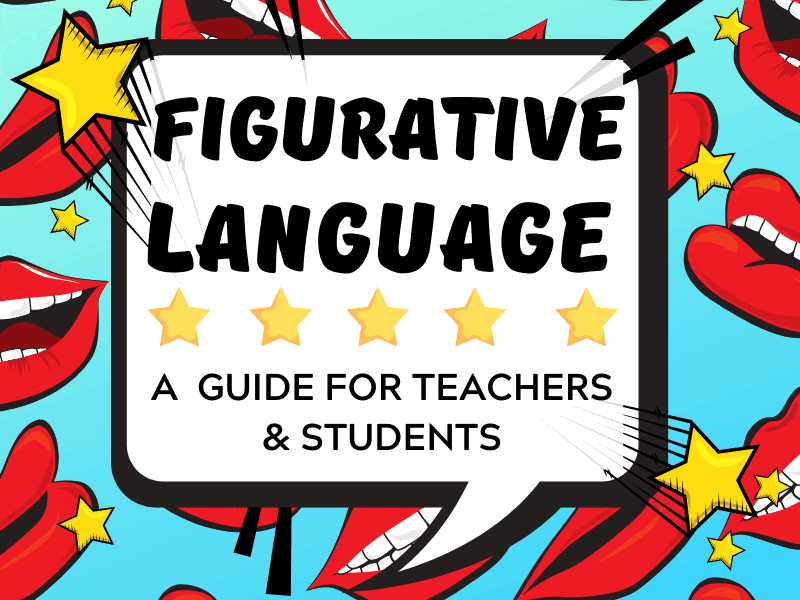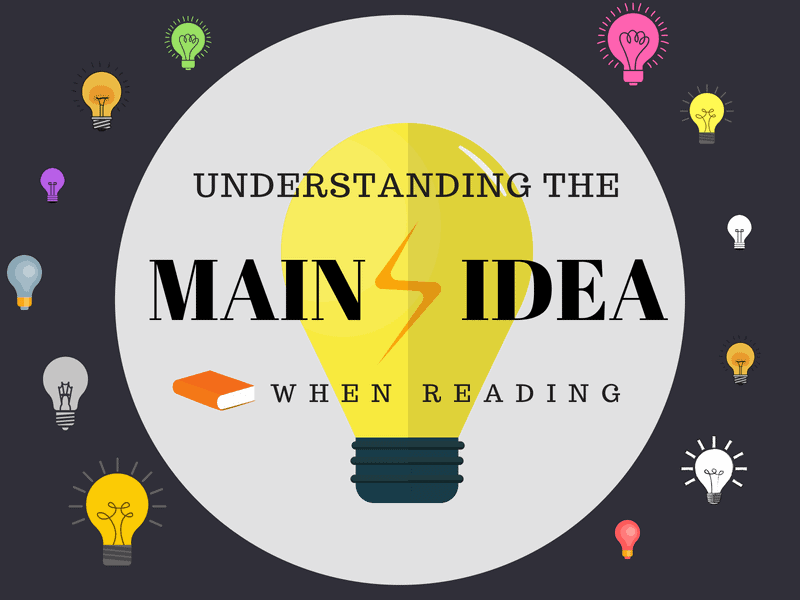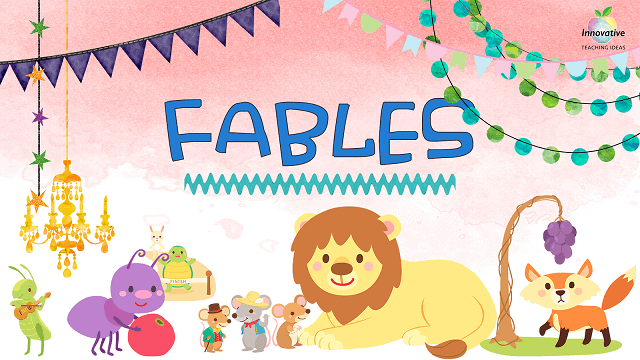
WHAT IS A FABLE?

Fables can be defined as short stories that are designed to convey a moral message to the reader or listener.
The origins of fables lie in oral storytelling traditions. Fables have passed on morals and life lessons for centuries across folk cultures worldwide, and they have been particularly important in the social development of children.
No surprise then that fables are designed to be extremely engaging for children. If you strain your memory back to your own school days, you might well recall a teacher, parent, or grandparent using a fable to illustrate correct behavior.
For example, when a child has been caught out repeatedly lying to get attention, the parent or teacher might relate to them the fable of Peter and the Wolf as a means of illustrating the potential risks of this type of behavior.
Where Can We Find Fables?
When we think of fables, we often think of stories that have been handed down to us from generation to generation. We think of Aesop’s fables that we heard in school as a child or had read to us by a parent at bedtime.
Some of the best-known fables commonly collected in anthologies include:
- The Hare and the Tortoise,
- The Fox and the Crow
- The Fox and the Grapes
- The Lion and the Mouse
- The Gnat and the Bull
- The Town Mouse and the Country Mouse
- The Frogs and the Ox
- The Wolf and the Crane
- The Owl and the Grasshopper
- The Crow and the Pitcher
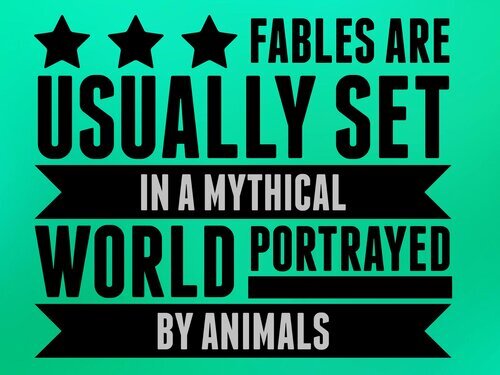
While many of the best-known fables are indeed ancient in origin, the form still survives today in modern writing. We can see this in works such as George Orwell’s Animal Farm and Richard Bach’s Jonathan Livingston Seagull.
In their modern incarnation, fables often take the form of satire, allowing the writer to criticize contemporary power structures without necessarily naming names.
A COMPLETE 97 PAGE UNIT ON FABLES – NO PREPARATION REQUIRED
What Are the Main Elements of a Fable?

Fables are a subset of folktales and are therefore closely related to fairy tales.
While these two cousin-genres share several common features, they can easily be distinguished from each other.
While both types of stories teach moral lessons through fantastical tales, fairy tales place more emphasis on the story than the moral.
In fables, on the other hand, the moral lesson lies at the very center of the plot.
Let’s take a closer look at this and the other main elements of fables in turn.
Fables CONVEY A MORAL MESSAGE

As with other stories, fables strive to entertain the listener or the reader. However, they also strive to convey a solid moral message by imparting important values and rules to live by.
While story is vital in fables, as in any form of fiction, it is important predominantly to communicate the underlying message. For this reason, fables are simply structured and avoid complexity of plot while using a minimal number of characters.
As mentioned, after the story’s climax and resolution, the fable’s moral lesson is usually shared in the form of a maxim. Maxims are easy to remember and we can see the legacy of many fables in the form of these maxims in our everyday speech, for example, Slow and steady wins the race from the Hare and the Tortoise and Out of the frying pan and into the fire from The Stag and the Lion.
As fables are repositories for the morals and values of a society, we can learn much about a culture from reading the fables that are popular within it.
The two examples above are from Aesop’s fables, reflecting the importance of Greek civilization’s influence and the values of western culture.
However, each culture has its own fables that embody its specific outlook on life.
A FABLE TELLS A STORY
Fables tell stories. They are a form of short fiction and contain many of the elements common to all forms of storytelling, both written and oral.
Fables are generally relatively short and contain only a few characters. Their plot is usually very straightforward and follows the simple story pattern involving the setting of a scene, the introduction of the characters, and a central problem or complication before rising action leads us toward a dramatic climax.
Loose ends are then tied up in the story’s resolution. In the fable, the resolution usually takes the form of a maxim that succinctly captures the story’s moral lesson.
Dialogue is frequently used to help bring character to life and drive the story’s action forward. It also acknowledges the forms oral origins.
This genre of fiction really does capture the power of storytelling at its best. A well-crafted fable is a driver for improving human behavior while also serving to entertain.
Fables use animals as characters.

So, we can understand the critical role of a moral message in fables, but why are animals used as protagonists rather than humans?
There are several reasons why. Written sources from the ancient Greeks reveal that animals were used rather than humans to highlight the fictional nature of the story and bring a lightness to the proceedings.
This allows the writer to avoid any tendency they may have to be over-moralistic or ‘preachy’ in their tale.
The symbolism inherent in using animals to represent humans suggests implicitly that some humans are determined to live more like animals rather than rise to meet the challenges of being a civilized human being.
This symbolism also allows for indirect criticism to be leveled at certain people or behaviors without incurring the risk of punishment or resistance.
It also creates a universality for the story’s message that frees it from the limitations of being tied to a specific time, place, or people.
Frequently in fables, natural phenomena such as the wind and sun are personified and take on a dynamic role in the tale’s action.
A Fable Entertains
A spoonful of sugar helps the medicine go down – as Mary Poppins would have it.
Fables are entertaining. Their longevity is proof enough of that. Not only does their entertaining nature ensure their survivability across the generations, but it ensures their digestibility too. Particularly among younger listeners and readers.
There is a humorous touch to many fables. A lightness that allows for the serious underlying message to be absorbed.
Fables work to improve human behavior through round-about means. Rather than prodding the reader critically, they offer advice in the much more palatable form of a made-up story.
HOW TO WRITE A FABULOUS FABLE (With Teaching Activities)
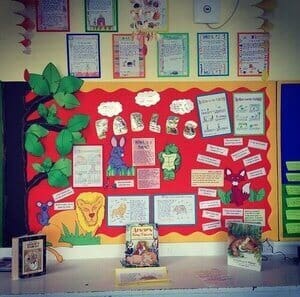
Once our students have a good grasp of the basic elements of a fable, they can try their hand at writing their own.
The process below will take the student through a step-by-step process they can follow to write their own fable. With a little adaptation, this process can also be used to write new versions of familiar fables.
Step 1: Decide on the Moral of the Tale
As mentioned, the moral lies at the very heart of any good fable. It stands to reason then that the moral will serve as the perfect starting point for writing a fable.
Morals are principles and values that are used to identify good behavior from bad. We can find them in numerous places. For example, many of them are embedded in our speech in the form of proverbs.
Proverbs are common sayings that express a general truth or lesson, such as Necessity is the mother of invention at the center of The Crow and the Pitcher.
Once the student has chosen what the moral they wish to illustrate is, they can then begin to build the structure of their story around it. But, where to find a fable-worthy moral?
Some commonly used proverbs in English that work well in stories include:
- Money can’t buy happiness
- Absence makes the heart grow fonder
- What goes around comes around
- Necessity is the mother of invention
- Look before you leap
- Honesty is the best policy
- Every cloud has a silver lining
- Don’t put all your eggs in one basket
The Moral of the Tale Teaching Activity
- First, organize the class into several smaller groups of around 4-5 students.
- Provide each group with copies of various fables or the collected fables of Aesop.
- Challenge students to read the various fables together.
- Can they identify the lesson in the story?
- Can the lesson of the story be summed up in a well-known proverb?
- Challenge the students to come up with as many proverbs as they can. The Internet will be a great resource to help here.
- Each student should then select a suitable proverb/moral to place at the center of their fable.
Step 2: Define a Conflict and Plan a Climax & Resolution

We’ve said it before on this site, and we’ll undoubtedly say it again. Conflict is the engine that drives the action when writing a story, and fables are no exception.
To have a story, we need a problem. Luckily, in fables, the problem is usually a very straightforward conflict between two polar opposites, e.g.,
- Good vs Evil
- Rich vs Poor
- Truth vs Falsehoods
- Lack vs Sufficiency
- Kindness vs Meanness
- Arrogance vs Humility
These opposing forces are typically embodied in the main characters, who are subsequently pitted against each other by circumstances. Often, when the conflict is decided upon, it will suggest an appropriate setting and suitable characters.
This conflict sets up a sequence of cause-and-effect events that will ultimately build towards the climax and resolution that will impart a relatable lesson to the reader.
It is usually best to plan these events out ahead of time to ensure the fable resolves in such a way as to illustrate the moral it was intended to.
Define a Conflict Teaching Activity
- First, students will need some practice identifying conflicts before creating their own. Organize the class into groups of 4 or 5 and provide them with some of Aesop’s fables.
- Have students read through the stories and identify the oppositional forces at work. Students should then work to express each conflict in the simplest terms, e.g., X vs. Y.
- Next, students should look at some of the sayings they listed in the previous activities. Can the students create related conflict scenarios for each proverb?
Plan a Climax & Resolution Teaching Activity
- Storyboarding can be a great way to map out the series of causes and effects that lead from the conflict, through the story’s climax, to its resolution.
- Provide your students with a blank storyboard template for them to sketch out their story’s arc.
- This activity also works well after the conflict, setting, and characters have been decided upon.
Step 3: Choose a Setting
This step is interchangeable with Step 4 as these two elements are inextricably linked.
Choosing a setting will often suggest specific types of animals as characters for the story. If the characters are chosen first, these will typically indicate a possible setting or two.
Wherever the student decides to set their fable, they must describe it in vivid detail.
Fables are simple tales, so rather than using lots of literary devices such as similes and metaphors, a few well-chosen adjectives and concrete nouns will be sufficient to paint a striking image in the reader’s mind.
Fables typically make use of a few familiar settings, so there is usually no need to over-egg the pudding by going into extensive detail. Some common settings include:
- The woods
- A castle
- A mountainside
- A village
- A farm
- The city.
Choose a Setting Teaching Activity
- Provide the students with various fables and ask them to list the settings for each, e.g., forest, farm, castle, city, etc. Students should also state the mood of the setting – this is often apparent in descriptions of the weather.
- Now, instruct students to take the location, mood, and weather and write a descriptive paragraph of their own to convey this setting. The focus here is on creating a description of the story’s environment, so there shouldn’t be any characters in this paragraph.
Step 4: Choose the Characters
The next step will involve choosing characters to act out the plot of the story. The characters in fables are not the laboriously drawn and psychologically authentic complex portraits that we might find in literary fiction or sophisticated thrillers. They are most often pretty one-dimensional archetypes that are used to act out some form of a conflict of opposites.
Students should decide on one or two specific traits for each character to embody.
Knowing which traits you wish to embody can also help in choosing specific types of characters. Reflecting on the story’s central conflict will help students to decide which characters and traits will best suit the needs of their story.
Just as in Aesop’s prototype fables, students can draw from the animal kingdom to ‘people’ their fictional world.
Woodland creatures serve well here. Creatures such as squirrels, foxes, mice, owls, etc., are all common fable-fare.
There’s no need either to come up with clever names. Aesop simply names his characters by type. All that’s required is to capitalize e.g. The Wolf, The Crow, etc.
Students can also use natural phenomena such as The Sun, The Moon, The Wind, etc., as characters in their tales. Again, students can just name these by type.
Characters and Their Traits Teaching Activity
- Instruct students to make a list of a dozen possible characters for use in their fables. These should include some natural phenomena, as well as animals.
- Alongside each of these characters, students should list traits commonly associated with each. For example, where The Fox may be sly, cunning, or crafty, The Owl might be considered wise, intelligent, insightful.
- Students can use dictionaries and thesauruses to help.
- When they’ve finished, students can compare their lists. How similar or different have the traits assigned to the same characters been?
STEP 5: Write, Edit, Proofread, Submit

By now, students should have all the raw material for their stories: a moral to communicate, a conflict to build a plot arc around, a setting to place the story in, characters to perform the actions, and a climax and resolution to tie things up.
Once they have completed their first draft, students should spend some time editing and proofreading their work before handing it in.
The editing and proofreading stage is a frequently overlooked part of the writing process and, yet, it is often the stage that has the most valuable writing lessons for students to learn. Make sure they don’t neglect it!
Editing & Proofreading Teaching Activity
- Assign each student an editing partner.
- Students swap their work and make mark-up editing suggestions on their partner’s work.
- The marked-up work is returned to each student, who then rewrites their fable in light of the suggestions.
- Partners swap their work for one final proofread before handing in their polished fables.
And So, To The Moral of the Tale
The beauty of writing in this genre lies in its simplicity. Once a clear moral has been chosen, the student has the broad coordinates of their ending, making the writing process all the more straightforward.
Remind students to focus on this moral throughout the writing process, and they won’t go far wrong.
Students should also avoid getting too wordy or constructing too complex a plot. They should aim clearly at ending their fable with a single, succinct final sentence that expresses the moral of the tale.
If they manage this, soon, your students will be writing fables to rival any tunic-wearing ancient Greek!
Teaching Resources
Use our resources and tools to improve your student’s writing skills through proven teaching strategies.
EXAMPLE OF A FABLE
